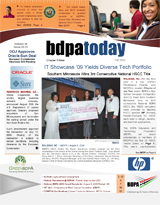|
|
|
bdpatoday
Volume 31 | 09.10.09 |
|
|
|
|
|
bdpatoday blogs, discussions,
and events are enhanced by
bdpatoday | online
Missed one? In case we missed you yesterday, our newsletter archives and Acronym of the Day are updated each week for new BDPA chapter interest groups (CIGs) and new BDPA members up to the last 100 online editions. Discover more...
Web 2.0 is Here to Stay-How About You?
Like it or loathe it, Web 2.0 is here to stay The reason? CNBC.com (CNBC) reports according to a survey in the latest issue of the McKinsey Quarterly, Web 2.0 technologies are providing serious business benefits for early adopters.
Some 69 percent of respondents to the consulting firm's survey "report that their companies have gained measurable business benefits, including more innovative products and services, more effective marketing, better access to knowledge, lower cost of doing business, and higher revenues."
Clearly, then, we've gone beyond the buzzword stage, and entered the realm where harnessing technology is an essential element of good business practice. And the good exec-or wannabe exec-will likely have a skillset that includes the ability to utilize and champion these technologies; the McKinsey report clearly indicates that successful adoption of Web 2.0 technologies throughout a company is greatly dependent on senior leaders modeling or championing them in the workplace. Select here to learn more... |
 Acronym of the Day Acronym of the Day

NBAR
Network Based Application Recognition (NBAR) is a mechanism that classifies and regulates bandwidth for network applications to ensure that available resources are utilized as efficiently as possible. Cisco Systems developed NBAR as part of its Content Networking platform for implementing intelligent network services.
NBAR allows network routers to recognize programs and take various actions based on that information. For example, a router might allocate all necessary bandwidth for mission-critical applications or flag low-priority, bandwidth-intensive applications for bandwidth throttling. The network administrator can view the mix of applications in use by the network at any given time and decide how much bandwidth to allow each application. (This regulation process is called bandwidth policing.)
Other capabilities of NBAR include:
-
Optimizing multiple-service performance.
-
Eliminating data-flow bottlenecks.
-
Minimizing latency.
-
Reducing or blocking spam.
-
Detecting and blocking malware.
-
Enhancing network security.
-
Easy addition of new protocols.
-
Reducing expenses and maximizing revenue.
One real-life example of NBAR in use was during the Code Red worm attacks of 2001. Most firewalls could not look into the HTTP data stream to identify Code Red traffic. However, implementation of NBAR made it possible to identify the suspect traffic and block access.
Source:
|
|
|
|
|
|
|
|
|
NROTC Scholarships
now on deck @ BDPA!
Cover story in bdpatoday
|
FALL 2009 Print Edition
Download versions available 
|
Bowie State University
vs.
Shaw Univeristy

September 26, 2009
|
|
|
|
 Save 50% Save 50% |
Develop ARRA STEM Partnerships with BDPA | Join a Chapter
Isn't there someone we know in the Greater Washington, D.C. Metropolitan area who currently is neither a member nor sponsor of the Washington, D.C. Chapter of BDPA? If so, use or pass along our coupon for them to partner with BDPA to advance community STEM (Science. Technology. Engineering. Mathematics) initiatives. Two (2) members may now join for the price of one this Labor Day Weekend through September 30, 2009. BDPA Chapter Members or Members of other non-profit organizations also may use this coupon to sign-up at least one friend, co-worker, relative, or neighbor that has expressed interest in STEM or seeking opportunities, relationships, and affiliations with information, technology, and communications (ICT) sector corporations within emerging vertical markets such as Aerospace & Defense, Construction, Education, Energy, Healthcare, or Transportation in the National Capital Region (NCR.)
Add value to your membership by adding value to others. Select here to join or become a patron. Annual membership dues are $75 and $15 for student members. |
BDPA-DC | Offer valid through September 30, 2009  | |
|
|
About BDPA-DC
NBDPA's Washington, D.C. Chapter was founded in 1978 by Norman Mays. It was incorporated in 1981 as a domestic not-for-profit corporation in the District of Columbia. In February of 1988, Black Data Processing Associates of Washington, D.C. Metropolitan Area (BDPA-DC) became an IRS Section 501(c)(3) Public Charity. Today, BDPA-DC provides professional development services for its members and stakeholders in direct support of local and regional STEM (Science. Technology. Engineering. Math) initiatives. Towards this end, BDPA-DC partners with BDPA Baltimore, BDPA Northern Virginia, and BDPA Richmond to support members and stakeholders within the National Capital Region (NCR) and the Baltimore-Richmond Corridor. BDPA-DC also serves NBDPA, BDPA Chapters and Chapter Interest Groups (CIGs) as a federal news bureau, government relations liaison, and bdpatoday newsletter clearinghouse for emerging NBDPA Chapters.
BDPA-DC
611 Pennsylvania Avenue, S.E., Suite 213
Washington, District of Columbia 20003, USA
|
| Select here to join, sign-up a co-worker, or renew memberships | |
|
bdpatoday ISSN 1946-1429 is published by BDPA-DC and participating NBDPA Chapters.
| |
|